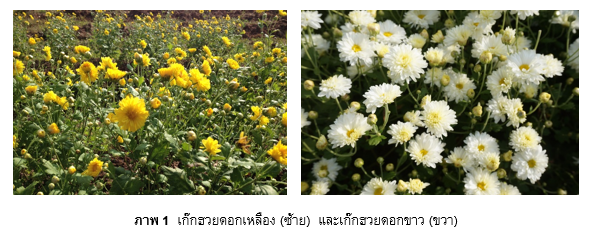Analysis of phenolic compounds content and free radical scavenging capacity of Chrysanthemum flower extracts
Keywords:
Chrysanthemum indicum, Chrysanthemum morifolium, free radical scavenging capacity, phenolic compoundsAbstract
The study was aimed to compare the content of phenolic compounds and flavonoids of Chrysanthemum indicum and Chrysanthemum morifolium flower extracts by using 2 types of solvents, 95 percent ethanol, and sterile distilled water. The results showed that the total amount of phenolic compounds of white chrysanthemum extracted with ethanol 95 percent concentration was highest is 343.40 ± 6.88 mg equivalent of gallic acid per gram of dry weight. In the other hand, the type of solvent does not affect the content of phenolic compounds of yellow chrysanthemum flowers. Extraction of yellow and white chrysanthemum flowers with ethanol resulted in a higher content of flavonoids than distilled water extracts, equivalent to 455.75 ± 12.38 and 441.92 ± 43.59 mg equivalent of catechin per gram dry weight, respectively. The extract has been found to be a good antioxidant by exhibit strong free radicals scavenging namely, 2,2-Diphenyl-1-picrylhydrazyl (DPPH) equal to 197.04 ± 1.57 mg equivalent of vitamin C per gram dry weight. In addition, the Chrysanthemum extracts can reduce iron that can accelerate oxidation and were not significant (p>0.01). The knowledge obtained can be used for optimization the conditions for extracting Chrysanthemum flowers in order to obtain both the quantity and quality of the substances that need to be applied in medical and commercial uses.
References
Luyen BTT, Tai BH, Thao NP, Cha JY, Lee HY, Lee YM, et al. Anti-inflammatory components of Chrysanthemum indicum flowers. Bioorg. Med. Chem. Lett. 2015;25(2):266-269.
Cui G, Niu Y, Wang H, Dong J, Yuki H, Chen S. Rapid isolation and identification of active antioxidant ingredients from Gongju using HPLC-DAD-ESI-MS and postcolumn derivatization. J. Agric. Food Chem. 2012;60(21):5407-5413.
Wu LY, Gao HZ, Wang XL, Ye JH, Lu JL, Liang YR. Analysis of chemical composition of Chrysanthemum indicum flowers by GC/MS and HPLC. J. Med. Plant Res. 2010;4(5):421-426.
Sharma P, Gujral HS. Antioxidant potential of wheat flour chapattis as affected by incorporating barley flour." LWT-Food Sci Technol. 2014;56(1):118-123.
Zhishen J, Mengcheng T. Jianming W. The determination of flavonoid contents in mulberry and their scavenging effects on superoxide radicals. Food Chem. 1999;64(4):555-559.
Miceli N, Trovato A, Dugo P, Cacciola F, Donato P, Marino A, et al. Comparative analysis of flavonoid profile, antioxidant and antimicrobial activity of the berries of Juniperus communis L. var. communis and Juniperus communis L. var. saxatilis Pall. from Turkey. J. Agric. Food Chem. 2009;57(15):6570-6577.
Phansawan Buran. Free radicals, antioxidants and antioxidant activity determination. J. Sci. Technol. 2013;21(3):275-286.
Wang W, Wang H, Zhang Y, Zu Y. In vitro antioxidant and antimicrobial activity of anthotaxy extracts from Dendranthema morifolium (Ramat.) Tzvel. and Chrysanthemum indicum L. J. Med. Plant Res. 2013;7(36): 2657-2661.
Miceli N, Trovato A, Dugo P, Cacciola F, Donato P, Marino A, et al. Comparativeanalysis of flavonoid profile, antioxidant and antimicrobial activity of the berries of Juniperus communis L. var. communis and Juniperus communis L. var. saxatilis Pall. from Turkey. J AgricFood Chem. 2009;57(15):6570-7.
Phansawan Buran.Free radicals, antioxidants and antioxidant activity determination.J SciTechnol. 2013;21(3):275-86.
Wang W, Wang H, Zhang Y,Zu Y. In vitro antioxidant and antimicrobial activity of anthotaxy extracts from Dendranthema mori-folium (Ramat.) Tzvel. and Chrysanthemum indicum L. J MedPlant Res. 2013;7(36): 2657-61.
Zheng W, WangSY. Antioxidant activity and phenolic compounds in selected herbs. JAgric Food Chem. 2001;49(11):5165-70.
SopittummakhunK, RattanasinganchanP. Extraction and determination of antioxidant activity in herbal plant. Huachiew Chalerm-prakiet Sci Technol J. 2017;3(1):86-94.

Downloads
Published
How to Cite
Issue
Section
License
Copyright (c) 2020 Naresuan Phayao Journal

This work is licensed under a Creative Commons Attribution-NonCommercial-NoDerivatives 4.0 International License.
ผู้นิพนธ์ต้องรับผิดชอบข้อความในบทนิพนธ์ของตน มหาวิทยาลัยพะเยาไม่จำเป็นต้องเห็นด้วยกับบทความที่ตีพิมพ์เสมอไป ผู้สนใจสามารถคัดลอก และนำไปใช้ได้ แต่จะต้องขออนุมัติเจ้าของ และได้รับการอนุมัติเป็นลายลักษณ์อักษรก่อน พร้อมกับมีการอ้างอิงและกล่าวคำขอบคุณให้ถูกต้องด้วย
The authors are themselves responsible for their contents. Signed articles may not always reflect the opinion of University of Phayao. The articles can be reproduced and reprinted, provided that permission is given by the authors and acknowledgement must be given.







